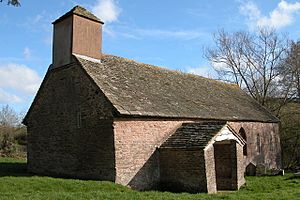St Michael's Church, Michaelchurch facts for kids
Quick facts for kids St Michael's Church, Michaelchurch |
|
|---|---|

St Michael's Church, Michaelchurch, from the south-west
|
|
| Lua error in Module:Location_map at line 420: attempt to index field 'wikibase' (a nil value). | |
| OS grid reference | SO 521 255 |
| Location | Michaelchurch, Herefordshire |
| Country | England |
| Denomination | Anglican |
| Website | Churches Conservation Trust |
| History | |
| Founded | 1056 (?) |
| Founder(s) | Herwald, Bishop of Llandaff (?) |
| Dedication | Saint Michael |
| Architecture | |
| Functional status | Redundant |
| Heritage designation | Grade II |
| Designated | 30 April 1986 |
| Architectural type | Church |
| Style | Norman |
| Specifications | |
| Materials | Sandstone, stone slate roofs |
St Michael's Church is a very old church in a quiet field in Herefordshire, England. It's not used for regular church services anymore, but it's kept safe by the Churches Conservation Trust. This church is special because it has amazing wall paintings from the 1200s and even a reconstructed Roman altar! It's also a "Grade II listed building," which means it's an important historical place. You can find it about 5 miles (8 km) west of Ross-on-Wye.
Contents
History of St Michael's Church
It is believed that St Michael's Church was first built around the year 1056. A bishop named Herwald from Llandaff is thought to have founded it. Over the centuries, the church was changed and updated. Some changes happened in the 1200s and 1600s. Later, in the late 1800s or early 1900s, it was "restored," which means it was repaired and brought back to good condition.
The Roman Altar Discovery
In 1830, a local church leader named Rev John Webb made an exciting discovery. He found a rectangular stone outside a cottage. People were using it as a simple bowl for grinding things. Rev Webb realized it was actually a Roman altar stone! He then found other parts of the altar, like its base, in a blocked-up doorway of the church.
The pieces were first moved to a nearby village church in Tretire. But in 1908, they were brought back to St Michael's Church. The church stopped being used for regular services on July 28, 1972. It was then officially given to the Churches Conservation Trust on November 13, 1973, to be looked after.
Church Architecture and Design
St Michael's Church is built from sandstone and has roofs made of stone slates. Its design is quite simple, which is common for old churches.
Outside the Church
The church has a main area called the nave and a smaller section called the chancel. There's also a porch on the south side where people would enter. On the west end of the church, there's a small bell tower with a pointed roof. The walls of this bell tower are covered in a smooth plaster.
On the north side of the nave, there's a doorway that is now blocked up. A modern window has been put there instead. On the south side, near the porch, you can see a tall, narrow window and another window with two lights under a pointed arch. The chancel has smaller, narrow windows on its sides and two taller ones on the east wall. Inside the porch, there are stone benches.
Inside the Church
The ceiling inside the church is plastered. The east and south walls of the chancel have wooden panels from the 1600s. But the most exciting parts are the 13th-century paintings on the north, east, and south walls. These paintings are mostly in red and white and show cool geometric shapes and flower designs.
Some parts of these old paintings are covered by black-lettered writings from the 1500s and 1600s. These writings include important religious texts like the Ten Commandments. Between the nave and the chancel, there's a wooden screen. This screen has a wide opening in the middle and three sections on each side. The bottom parts of these sections are paneled, and the top parts have open arches.
The wooden seats for the choir were added in the 1800s and have carved angels on them. The stone baptismal font is very old, from the 1100s. It has a round bowl with a cross and woven patterns carved into it. Near the font, there's a stone coffin lid from the 1300s with a cross carved in a circle. The stand for reading (called a lectern) was probably added in the 1800s.
The reconstructed Roman altar stands in the blocked north doorway. It has an inscription that is hard to read now. But it roughly says, "To the god of the three ways (crossroads), Beccicus dedicates this altar." This shows how ancient history is part of this church!
Churchyard Features
The churchyard, which is the area around the church, has two war graves. One is for a soldier who died in World War I, and the other is for a Royal Navy officer from World War II. These graves remind us of people who served their country.
See also

